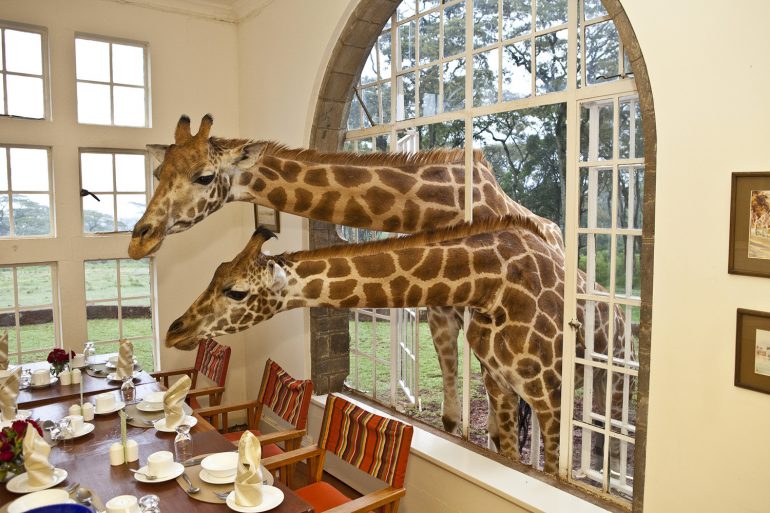In 1974, Betty and Jock Leslie-Melville – she American, he Kenyan – bought the manor house and a small parcel of Duncan’s original acreage. However, when they turned up to take possession of their new home, they found that three wild bull giraffes had decided it was already occupied. The Leslie-Melvilles named their obstinate housemates Tom, Dick and Harry. Soon, as word spread about their unusual living arrangement, Betty and Jock found themselves with other Rothschild giraffes – refugees suffering from the impact of the Kenyan government’s program to develop the countryside. New additions to the family included Daisy, about which Betty Leslie-Melville wrote a famous book, Raising Daisy Rothschild, which later became a movie; and Marlon, named in honour of Marlon Brando.
Betty’s son turned the restored manor into a small hotel in 1984. Though it has since changed hands and now comprises part of the Safari Collection, with sister properties scattered through the country, the guiding ethos has remained unaltered: to spotlight an animal often overlooked by visitors coming to Africa in search of the “Big Five” – the African lion, African elephant, Cape buffalo, African leopard, and white or black rhinoceros.
Giraffes, the hotel argues, are just as sexy as any of those.
This became particularly clear at the daily sundowner, served on a terrace overlooking the manor’s wide lawn. As you take a seat and order a drink, a woman nearby placed a pellet between her lips and then pouted into the air. Seemingly out of nowhere, a giraffe leant down, hovered over her face, and began lashing her with its long purple tongue.
“Oh, you kissed him,” cooed an older woman. “Isn’t that a nice thing to do.”
According to the Giraffe Conservation Fund, the giraffe population of Africa has plummeted 40 per cent in just 15 years, largely owing to habitat loss. This “silent extinction”, as one scientist has called it, means just 80,000 animals remain today.
When it comes to the Rothschild species, the situation is even more grim. Just 1100 remain, which means, as a staff member helpfully points out, that Giraffe Manor has one per cent of the entire population of Rothschilds on earth.
For that reason, a non-profit Giraffe Centre attached to hotel is pursuing an aggressive breeding program. Founded by the Leslie-Melvilles in 1979, the centre, which is part of the African Fund for Endangered Wildlife, tries to encourage population growth while educating people on what needs to be done to reverse the downward spiral. Like the nearby David Sheldrick Wildlife Trust, which rescues orphaned elephants, raises them, then releases back into the wild, this is amusing attraction with a serious goal.
On my second day at the hotel, a man knocked on my door at 6.30 in the morning. “The giraffes are coming,” he announced, as though we were being invaded.
I pulled back the mosquito net, then the curtain. I opened the glass shutter. Crimson sunlight streamed into the room: another perfect day in Africa. Within minutes, as though I’d woken into a Dali painting, a giant yellow head appeared at the window, its eyes slowly blinking.
Personally, I’ve always been fond of the giraffe as an elegant symbol of evolution. Darwin once wrote, “It seems to me almost certain that an ordinary hoofed quadruped might be converted into a giraffe.” How beautiful their patterns are, and how strange their telescoping necks. How did this happen? To be around them for a day, a night, an early morning breakfast, their shadow on the white tablecloth, is to be delighted into awe.



